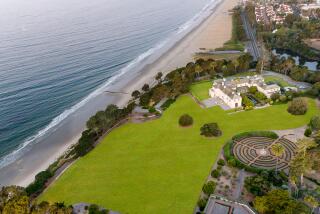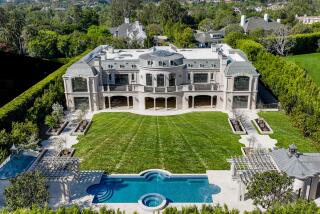Philippine First Lady Linked to N.Y. Estate : Marcos Inquiry Trail Leads to Mansion
- Share via
CENTER MORICHES, N.Y. — Flanked by towering linden trees and a pagoda-shaped pool house, the elegant white neoclassical mansion called Lindenmere stands by the shores of broad Moriches Bay. On a brisk, blustery day, few boats sail the cold waters. Only the whistling wind and the squawking sea gulls break the wintry silence.
But the unoccupied 38-room mansion and its 13.4-acre estate have become the centerpiece of a controversial congressional probe into allegations that Philippine President Ferdinand E. Marcos and his wife, Imelda, may have diverted U.S. foreign aid and secretly invested hundreds of millions of dollars in American real estate.
The Marcos family has denied owning any property in the United States, and it is not illegal for foreigners to own property here. But in the midst of a bitter Philippine presidential campaign, allegations that Marcos and his wife have funneled a fortune into U.S. real estate led to an unsuccessful impeachment resolution in the National Assembly in Manila last August, and have become a sensitive political issue in the Feb. 7 election.
The evidence of their involvement at Lindenmere, about 65 miles from Manhattan, on the south shore of eastern Long Island, includes a trail of real estate transactions, local tax records and lawsuits. It also includes Imelda Marcos’ repeated inspection tours during the renovation of the rundown property after it was bought in late 1980 by a group of Philippine-born businessmen.
On one trip, Imelda Marcos studied the oaken grand staircase in the main hall and registered a complaint: The number of stairs was unlucky.
“The stairs had to be in threes,” recalled local builder Ernest Hoffsteatter Jr., 41. “It was a bad omen. Then we counted the landing as a step. So we were OK.”
Hoffsteatter said he met and chatted with Imelda Marcos “about five times” in 1981, when he was supervising extensive renovations at Lindenmere. Touring the house each time, she chose Jacuzzis and gold-plated bathroom fixtures, picked an all-white color scheme in the master bedroom, ordered a bathtub installed off the main dining room, chose cedar walls here, marble floors there.
In lighter moments, she posed smiling for photos on the porch with Hoffsteatter and his son, and with Filipino associates. She presided at lavish lobster and steak barbecues under striped garden tents, and even taught Hoffsteatter to grill unhusked corn the Filipino way, instead of boiling it.
“She said, ‘This is the way we do it in the Philippines,’ ” he recalled. “It was delicious.”
She Stopped for Tea
Imelda Marcos even stopped to take tea and thank the real estate broker who had arranged the purchase of the stately mansion, which was built in 1910 as a private residence and reputedly based on a design by famed architect Stanford White.
“She just stopped in and had a cup of tea,” said real estate agent John E. Sprague, 71, as his wife, Margaret, nodded in their warm, cluttered kitchen a block from Lindenmere. “We met twice here in the house, maybe once or twice at the property.”
Lindenmere is not the only property at issue in the scrutiny of the Marcos family’s American holdings.
In Washington, Rep. Stephen J. Solarz (D-N.Y.), chairman of the House Foreign Affairs subcommittee on Asia and the Pacific, charged in hearings this week that the Marcos family has used a web of offshore holding companies and business associates to buy not only Lindenmere, but also a posh nine-story Manhattan shopping center called Herald Center, two prestigious mid-Manhattan office towers, the largest office building on Wall Street, and a 13-acre estate in Princeton, N.J.
Estimated $350 Million
Solarz estimated the properties to be worth $350 million, and accused Marcos of practicing “crony capitalism . . . on a colossal scale.”
But Rep. Gerald B.H. Solomon (R-N.Y.) denounced the hearings as a “charade” and a “witch hunt” intended to influence the election. He and other critics say congressional investigators have not found hard proof of Marcos ownership.
“I don’t think we’re ever going to see Marcos’ name on a piece of paper saying, ‘I own this,’ ” responds Solarz spokesman David Frank.
But documents do exist linking the Marcos family to Lindenmere.
A hotel-turned-health-spa in the late 1970s, Lindenmere--which consisted of the main house with 20 bedrooms and nine bathrooms, a nearby carriage house converted into six apartments, and a dozen nearby efficiency apartment units--was sold for $374,500 in late 1980 to a group of Philippine-born businessmen representing the Luna Seven Development Corp. They also bought two adjoining lots, paying $585,000 in all for the 13.4 acres.
“As a broker, I can tell you it’s probably worth $3 million today,” said John Sprague, a spry white-haired former Army commando who wears jaunty berets and runs Sprague Real Estate from his home.
Renovated Property
The new owners, architect Augusto M. Camacho and Dr. Pablo E. Figueroa, immediately ordered more than $1 million in renovations of the house and grounds, including new roofs, plumbing, heating, windows and more. They told Sprague and Hoffsteatter they planned to build a plush condominium resort.
“They put in a huge swimming pool and a very large guest-type gazebo that has a fireplace that could cook a whole bullock,” Sprague said.
Imelda Marcos appeared during those renovations, usually accompanied by a bus or van full of Filipino friends and associates, and machine-gun toting bodyguards. Hoffsteatter said Camacho repeatedly told him that tales of her visits should be “quieted down.”
But the only opposition from the surrounding middle-class community of 5,800 came when someone asked whether the Asian-looking owners of Luna Seven actually worked for the Rev. Sun Myung Moon, the Korean evangelist. Luna is the Latin word for moon.
“Everyone thought it was one of Rev. Moon’s operations,” Hoffsteatter said. “I had to take care of that.”
Sued Imelda Marcos
But by 1982, ownership of the property was transferred to a Curacao corporation called Ancor Holdings N.V. And in February, 1984, Figueroa and Camacho each sued Imelda Marcos and other partners for $1 million in state Supreme Court in Suffolk County, saying that “Marcos decided to make Lindenmere into her private personal estate and discontinued the development of the $19-million resort.”
Both suits charged that Imelda Marcos “does business in New York State systematically and continuously” and that her activities include “extensive real estate purchasing, improving, developing and managing.” The suits also charged that she uses agents to “keep hidden her personal direct participation and involvement” in the transactions.
Figueroa dropped his suit after receiving $20,000 in legal fees, his lawyer testified last week. Figueroa could not be reached Friday. Camacho settled for $875,000 for his work as architect and contractor at Lindenmere, his lawyer said. A man who answered the telephone at Camacho’s New York apartment this week said he was out of town.
According to Suffolk County tax records, a woman named Vilma H. Bautista paid more than $36,000 on behalf of Ancor Holding to pay 1984 and 1985 real estate taxes. Bautista, who appeared in one of the photographs taken with Imelda Marcos at Lindenmere, serves as her personal secretary when she travels in the United States.
Congressional investigators have identified Bautista as a secretary at the Philippine Mission to the United Nations. A spokesman at the mission said Friday that Bautista was on leave in the Philippines and could not be reached.
Lindenmere itself appeared deserted behind “Keep Out” signs and wooden fences Thursday. Neighbors say an elderly woman works as caretaker, helped by two Filipino men. No one answered at the doors, and a brown dog stretching beside garbage cans was the only sign of life.
More to Read
Sign up for Essential California
The most important California stories and recommendations in your inbox every morning.
You may occasionally receive promotional content from the Los Angeles Times.







